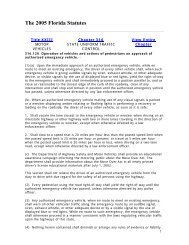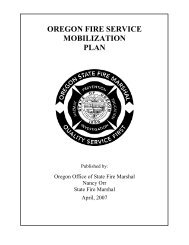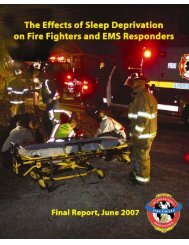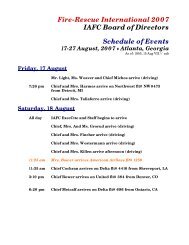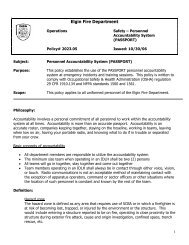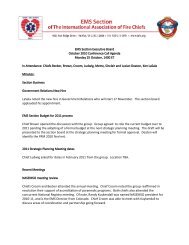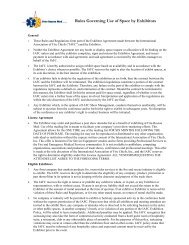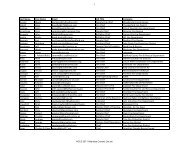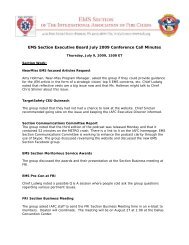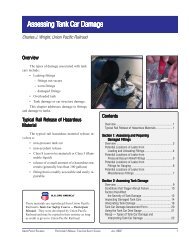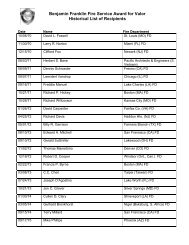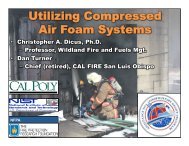DISCIPLINARY ACTION CHECKLIST - IAFC
DISCIPLINARY ACTION CHECKLIST - IAFC
DISCIPLINARY ACTION CHECKLIST - IAFC
You also want an ePaper? Increase the reach of your titles
YUMPU automatically turns print PDFs into web optimized ePapers that Google loves.
DONNA AVERSA<br />
Leonard & Felker, P. L. C.<br />
and<br />
BRENDA TRANCHINA<br />
Human Resource Strategies, L.L.C.<br />
FRI 2009<br />
Fire-Rescue International<br />
August 25, 2009<br />
Dallas, TX<br />
1
SPEAKER BIOGRAPHIES<br />
Donna Aversa is a partner in Leonard & Felker, P.L.C., a law firm based in<br />
Tucson, Arizona. Her practice is focused on working with fire districts regarding a<br />
wide variety of issues including: policy development, implementation and training;<br />
employment issues; litigation; and government regulation and compliance. She is<br />
a regular instructor at the semi-annual Arizona Fire District Association<br />
conferences where she provides training to fire boards, chief officers, and<br />
company officers. Donna spent over ten years as an adjunct faculty member at<br />
the Tucson campus of the University of Phoenix teaching graduate and<br />
undergraduate classes in business law, employment law and ethics. Donna was<br />
a presenter at the International Association of Fire Chiefs’ 2008 FRI.<br />
Brenda Tranchina is the President of Human Resource Strategies, LLC, an<br />
Arizona-based consulting firm specializing in HR management in the fire service.<br />
Understanding that the employment world of the fire service has unique<br />
challenges, Brenda has focused her business in the past 15+ years on partnering<br />
with fire departments to better protect and manage their most important assets:<br />
their employees. An integral part of her practice involves HR policy development,<br />
employee and management training, development and administration of<br />
promotional assessment centers, EEO investigations, employment law<br />
compliance, and coaching/counseling on employee relations matters. Certified<br />
as a Senior Professional in Human Resource (SPHR), Brenda is a regular<br />
instructor at the semi-annual Arizona Fire District Association conferences, a<br />
past instructor at Fire Rescue West, Arizona Fire Chief’s Association, and the<br />
California Special District Institute.<br />
Brenda Tranchina, SPHR<br />
Donna Aversa, Esq.<br />
President<br />
Partner<br />
Human Resource Strategies, LLC<br />
Leonard & Felker, P.L.C.<br />
419 W. Dream Weaver Drive 7440 N. Oracle Road<br />
Tucson, AZ 85737 Tucson, AZ 85704<br />
(520) 297-9351 (520) 742-0440<br />
brendahrs@aol.com<br />
dmaversa@slfpc.com<br />
2
<strong>CHECKLIST</strong>S FOR WORKPLACE INVESTIGATIONS<br />
INTO EMPLOYEE WRONGDOING<br />
KNOWING WHEN YOU NEED TO INVESTIGATE<br />
[ ] Information “triggers” that can launch an inquiry or an investigation of an<br />
alleged incident may include:<br />
[ ] Anonymous communication (verbal or written)<br />
[ ] Observation of conduct<br />
[ ] Receipt of complaint<br />
[ ] Receipt of outside agency complaint (i.e., EEOC, OSHA, law<br />
enforcement)<br />
[ ] Other report of potential policy/rule violation<br />
[ ] Initial inquiry to determine whether the alleged incident affects the<br />
workplace<br />
[ ] Initial inquiry may:<br />
[ ] Provide adequate information to enable the Department to<br />
determine what occurred and implement appropriate remedial<br />
actions, if necessary; or<br />
[ ] Provide adequate information to enable the Department to<br />
determine no inappropriate occurred, or<br />
[ ] Reveal information that causes the Department to begin a full<br />
investigation<br />
WHO SHOULD INVESTIGATE: INTERNAL VS. EXTERNAL?<br />
[ ] Department policy on internal vs. external investigator<br />
[ ] Past practices<br />
[ ] Nature of the allegation<br />
[ ] Harassment/Discrimination -- Consider an HR or Legal Expert<br />
[ ] Financial fraud/mismanagement -- Consider a CPA/Auditor<br />
3
[ ] Operational Issue (apparatus/equipment damage) -- Consider<br />
internal investigator<br />
[ ] Neutral; unbiased; no level of involvement in the incident<br />
[ ] Trained in conducting workplace investigations<br />
[ ] Experienced in fire service investigations<br />
[ ] Team approach may be appropriate<br />
[ ] Consider investigator’s ability as an effective witness in the event of<br />
litigation?<br />
DEVELOPING THE INVESTIGATION PLAN<br />
[ ] Gather related information<br />
[ ] Allegations<br />
[ ] Written complaint/allegation<br />
[ ] Information from other sources may require investigator to<br />
identify the specific complaint/allegation<br />
[ ] Documents (i.e., memos, letters, E-mails, pictures)<br />
[ ] Departmental policies, procedures, SOG’s, SOP’s, etc.<br />
[ ] Determine the scope of the investigation<br />
[ ] Identify the facts on which to base a determination of whether or<br />
not a policy violation occurred<br />
[ ] Identify potential witnesses<br />
[ ] Outline potential questions related to the alleged policy violation<br />
[ ] It’s not a fishing expedition!<br />
[ ] Evaluate the need for any temporary adjustments to the workplace/work<br />
assignments<br />
[ ] Administrative Leave w/ Pay<br />
[ ] Complainant<br />
[ ] Individual who is the subject of the investigation<br />
[ ] Reassignment or readjustment of schedules<br />
[ ] Give consideration to potential perception of retaliation<br />
4
[ ] Plan the logistics of the investigation<br />
[ ] Timing -- the sooner after the alleged incident, the better<br />
[ ] Location -- use discretion<br />
[ ] On duty vs. off duty interviews<br />
[ ] Determine method of documentation<br />
[ ] Handwritten notes<br />
[ ] Computer typed notes<br />
[ ] Audio recording<br />
[ ] Who will be present?<br />
[ ] Investigator<br />
[ ] Employee<br />
[ ] Union representative (if applicable)<br />
[ ] Employee’s representative<br />
• Depending upon state law/union contract<br />
• Not required to inform employee of the right to have someone<br />
else present<br />
• Not required to allow if there is no potential for disciplinary<br />
action against that employee<br />
• But, why not? What’s the downfall?<br />
[ ] Provide notice of investigation (see sample memo)<br />
[ ] Determine if Garrity Warning should be issued<br />
[ ] Applicable if there is potential for criminal prosecution for the<br />
person being interviewed<br />
CONDUCTING THE INVESTIGATIVE INTERVIEWS<br />
[ ] Determine the order of interviews<br />
[ ] Complainant<br />
[ ] Witnesses<br />
[ ] Subject of the Investigation<br />
[ ] Conduct interviews<br />
5
[ ] Look at the Who/What/When/Where/How?<br />
[ ] Start with general questions, narrow to more specific questions<br />
[ ] May need to ask same question in different ways in order to<br />
determine consistency in the interviewee’s statements<br />
[ ] Have relevant documents available for use in interviews (i.e., policies, E-<br />
mails, bank statements, accident reports)<br />
[ ] Pay attention and document body language, eye contact, other non-verbal<br />
communication<br />
[ ] Ask about facts<br />
[ ] Ask “Is there anything else?”<br />
[ ] Remain neutral<br />
[ ] Do not promise confidentiality<br />
[ ] Remind interviewees not to discuss the investigation with fellow<br />
employees<br />
[ ] Remind interviewees that retaliation will not be tolerated<br />
[ ] Be consistent in your approach<br />
[ ] Stick to the scope<br />
[ ] Revisit your plan and revise as necessary<br />
[ ] DOCUMENT, DOCUMENT, DOCUMENT!<br />
TYING IT ALL TOGETHER -- REPORT OF FINDINGS<br />
[ ] Review and compile investigative notes/tapes<br />
[ ] Review and determine relevancy of documents<br />
[ ] Review and determine relevancy of witness statements<br />
[ ] Assess and document credibility of witnesses<br />
[ ] Based on facts<br />
[ ] Corroboration of other witnesses’ statements or documents<br />
[ ] Observation of non-verbal communications<br />
[ ] Consistency of statements<br />
6
[ ] Prepare written report of findings<br />
[ ] State the scope of the investigation<br />
[ ] List witnesses and documents used as evidence<br />
[ ] Summarize information from each document and witness<br />
[ ] Assess credibility of evidence and its’ relevancy to the matter of the<br />
investigation<br />
[ ] State findings of fact on each element of the alleged<br />
offense/violation<br />
[ ] Include relative documents in report or appendix to the report<br />
[ ] Determine if recommendations for action are to be part of the report; if so,<br />
it should follow the findings of fact<br />
[ ] The report may be a matter of public record<br />
7
<strong>DISCIPLINARY</strong> <strong>ACTION</strong> <strong>CHECKLIST</strong><br />
[ ] Review investigation report and related documents<br />
[ ] Review disciplinary policy<br />
[ ] Probationary or non-probationary employee?<br />
[ ] Identify the infraction(s).<br />
[ ] Does the conduct impact the workplace?<br />
[ ] Does the conduct violate specific written policy, SOG, SOP,<br />
administrative directive, code of conduct?<br />
[ ] Past practice for similar infractions<br />
[ ] Consistency in discipline<br />
[ ] Prior disciplinary action for this employee<br />
[ ] Relevance<br />
[ ] Considerations in determining appropriate disciplinary action<br />
[ ] Nature and severity of the offense<br />
[ ] Prior offenses, similar or otherwise<br />
[ ] Document reasons for determining appropriate level of discipline<br />
[ ] If investigator gave a recommendation, document reasons for<br />
agreeing or disagreeing with recommendation<br />
[ ] Progressive discipline steps:<br />
[ ] Counseling<br />
[ ] Oral reprimand / admonishment<br />
[ ] Written reprimand<br />
[ ] Disciplinary suspension<br />
[ ] Demotion<br />
[ ] Dismissal / termination of employment<br />
8
DUE PROCESS RIGHTS <strong>CHECKLIST</strong><br />
[ ] Follow M.O.U. or other Union contract agreements<br />
[ ] Issue pre-disciplinary notice (Letter of Intent to Discipline)<br />
[ ] State all reasons for intended disciplinary action<br />
[ ] Indicate intended action and associated timing<br />
[ ] Provide opportunity for employee to respond to the charges prior to<br />
implementation of discipline<br />
[ ] State required timing of response, along with notification of result of<br />
failure to respond<br />
[ ] Pre-Disciplinary Hearing -- Allowing employee to respond<br />
[ ] Who may attend?<br />
[ ] Any limitation on participation?<br />
[ ] Loudermill hearing<br />
[ ] Employer must inform employee of his rights to union<br />
representation<br />
[ ] Union representative may speak on behalf of the employee<br />
[ ] Consider employee’s response<br />
[ ] Review facts, policies, past practices<br />
[ ] Make final disciplinary action determination<br />
[ ] Issue Letter of Disciplinary Action<br />
[ ] Reference Letter of Intent to Discipline<br />
[ ] State that information presented was considered<br />
[ ] Uphold/modify/revoke original intended action<br />
[ ] State timing of implementation of action<br />
[ ] Provide notice of right to appeal under policy<br />
[ ] Consider fallout within the department<br />
[ ] Consider fallout in the community<br />
[ ] Prepare for Post-Disciplinary Due Process<br />
9
<strong>DISCIPLINARY</strong> APPEAL PROCESS <strong>CHECKLIST</strong><br />
[ ] Review and follow the policy/union contract<br />
[ ] Appeal rights should be referenced in the notice of disciplinary action<br />
[ ] Reference the appeal process as set forth under policy, or<br />
[ ] Outline the appeal process if no policy/procedure exists<br />
[ ] Require employee to submit request for appeal<br />
[ ] Notify individual/entity responsible for hearing the appeal<br />
[ ] Initiate scheduling of the appeal hearing<br />
[ ] Inform employee of appeal hearing schedule, location, etc.<br />
[ ] Confirm in writing all deadlines set forth under the policy<br />
[ ] Be prepared to present all evidence to be used<br />
[ ] Documents<br />
[ ] Witness testimony<br />
[ ] Arrange for participation of witnesses/subpoena<br />
[ ] Decision “final” or “recommended”<br />
[ ] If “final” decision, follow accordingly<br />
[ ] If “recommended” decision, review all pertinent information and<br />
make final determination to either uphold or modify the original<br />
disciplinary action<br />
[ ] Notify employee of final action<br />
10
SEVEN TESTS OF “JUST CAUSE” FOR TERMINATION<br />
[ ] Did the Department give the employee forewarning or foreknowledge of<br />
the possible or probable disciplinary consequences of the employee's<br />
conduct? Is the existence of a policy or SOP sufficient?<br />
[ ] Was the Department’s policy reasonably related to:<br />
[ ] the orderly, efficient, and safe operation of the Department’s<br />
business, and<br />
[ ] the performance that the Department might properly expect of the<br />
employee?<br />
[ ] Did the Department, before administering discipline to the employee,<br />
make an effort to discover whether the employee did in fact violate or<br />
disobey a policy?<br />
[ ] Was the Department’s investigation conducted fairly and objectively?<br />
[ ] Did Investigator obtain substantial evidence or proof that the employee<br />
violated policy or engaged in inappropriate conduct?<br />
[ ] Has the Department applied its rules, orders and penalties evenhandedly<br />
and without discrimination to all employees?<br />
[ ] Was the degree of discipline administered by the Department in a<br />
particular case reasonably related to:<br />
[ ] the seriousness of the proven offense, and<br />
[ ] the record of the employee’s service with the Department?<br />
11
SAMPLE WORKPLACE NOTICE OF INVESTIGATION<br />
TO:<br />
FROM:<br />
Employee<br />
Fire Chief _____<br />
DATE:<br />
RE:<br />
Upcoming Workplace Investigation<br />
Please be informed that you may be contacted by ______________________ in<br />
the next week as part of a workplace investigation that is being conducted as a<br />
result of a potential violation of Department policy.<br />
Our Department is committed to careful and thorough investigation of policy<br />
violations. You are required to cooperate to the fullest extent possible,<br />
answering questions and providing accurate information as requested in the<br />
investigative process.<br />
Please understand that due to the sensitive nature of the process, this<br />
investigation will be conducted in a manner that protects the privacy of all<br />
involved to the greatest extent possible. In order to maintain the integrity of the<br />
investigation, you are directed to refrain from discussing the investigation with<br />
your fellow employees.<br />
The Department will not tolerate any form of retaliation toward any individual who<br />
participates in good faith in the investigative process.<br />
If you have any questions regarding the investigative process, please feel free to<br />
contact me. Thank you for your cooperation.<br />
12
SAMPLE LETTER OF INTENDED DISCIPLINE<br />
TO:<br />
FROM:<br />
Firefighter<br />
Fire Chief<br />
DATE: May 4, 2009<br />
RE:<br />
Letter of Intent to Terminate Employment<br />
This letter serves to inform you of my intention to terminate your employment<br />
with the XYZ Fire Department. This decision is based upon my recent finding<br />
that your Arizona Driver’s License was suspended for the time period of<br />
November 7, 2008 – February 6, 2009, and again on March 22, 2009. When I<br />
discussed this with you, you acknowledged that you were fully aware of the first<br />
suspension, but had not informed your supervisor. You stated that in settling the<br />
first suspension, the court directed you to take a driver’s education course, which<br />
you failed to complete. You also claimed that you were unaware of the most<br />
recent suspension, and surmised that you had never reported a change of<br />
address to the Motor Vehicle Decision, so you did not receive the notice.<br />
The XYZ Fire Department policy entitled “Standards of Conduct” states that<br />
“failure to maintain current and proper licenses and/or certification required to<br />
perform assigned duties” would subject one to disciplinary action, up to and<br />
including termination. You have violated this policy in both of the instances noted<br />
above. Furthermore, you failed to report that your driver’s license was<br />
suspended and you continued to drive Department apparatus.<br />
Thus, not only have you violated Department policy, but you also violated the law.<br />
Accordingly, you have placed the Department at tremendous risk. Based on<br />
these violations, I have concluded that termination of employment is the prudent<br />
action.<br />
You have the opportunity to respond to this notice within three business days of<br />
receipt if you wish to have a pre-termination meeting in which you may present<br />
any additional information that you believe may impact my final decision. Failure<br />
to respond within three business days will waive your right to a pre-termination<br />
meeting; if I do not hear from you within three business days, I will proceed with<br />
the termination of your employment. You will then be entitled to the appeals<br />
process as set forth in the XYZ Fire Department Human Resource Policy Manual.<br />
13
WHAT IS GARRITY?<br />
The so-called Garrity warnings or Garrity rights arise from a 1967 Supreme<br />
Court case, Garrity v. New Jersey. The United States Supreme Court decided<br />
that a law enforcement officer does not give up his Fifth Amendment Right to be<br />
free from compulsory self-incrimination by becoming a law enforcement officer.<br />
The issuance of a Garrity warning provides a firefighter with use immunity. That<br />
means the firefighter may be compelled to provide statements under threat of<br />
discipline, including discharge, and those statements may not be used in criminal<br />
prosecution against that firefighter.<br />
Caution: If a suspected policy violation raises the potential for criminal<br />
investigation, seek legal advice before undertaking the investigation. Do not<br />
issue a Garrity warning without first consulting the attorney advising the<br />
Department.<br />
Garrity requirements:<br />
• The firefighter must be given an order to answer questions under<br />
threat of disciplinary actions;<br />
• The questions must be specifically, directly and narrowly related to the<br />
firefighter’s duties or fitness for duty; and<br />
• The firefighter must be advised that the answers will not be used<br />
against the firefighter in criminal prosecution.<br />
What is a compelled statement?<br />
The order to answer questions may be oral, written or implied. The best<br />
practice is to have documentation on the issuance of the Garrity warning.<br />
Generally, reports prepared by a firefighter in the regular course of the job<br />
are not compelled statements for purposes of providing use immunity<br />
under Garrity.<br />
Statements given in response to Garrity can still be used for:<br />
• civil litigation against the firefighter,<br />
• disciplinary action against the firefighter,<br />
• disciplinary action against another firefighter,<br />
• criminal prosecution against another person.<br />
14
Is the Department required to give a firefighter Garrity warnings?<br />
Garrity only applies if there is a potential for compulsory self-incrimination.<br />
There is no requirement that the Department issue a Garrity warning. The<br />
Department can give the firefighter the choice of:<br />
• make no statement and have the discipline based on other evidence,<br />
or<br />
• make a voluntary statement which may be used in a criminal<br />
proceeding.<br />
15
SAMPLE GARRITY WARNING<br />
I. At this time, I am going to question you regarding:<br />
___________________________________________________________<br />
___________________________________________________________<br />
II.<br />
III.<br />
IV.<br />
This questioning concerns administrative matters relating to the XYZ Fire<br />
Department. During the course of this questioning, if you disclose<br />
information which indicates that you may be guilty of criminal conduct,<br />
neither your self-incriminating statements nor the fruits of any selfincriminating<br />
statements that you make will be used against you in a<br />
criminal legal proceeding, except your statements may be used related to<br />
perjury or impeachment.<br />
Because this is an administrative matter, you are required to answer my<br />
questions fully and truthfully. Your statements may be used against you<br />
regarding your ability to carry out your job functions and for disciplinary<br />
purposes.<br />
You are entitled to all rights and privileges guaranteed by the Arizona<br />
Constitution and the United States Constitution. You may have an attorney,<br />
union representative or another employee present with you during this<br />
interview.<br />
V. If you refuse to answer all of my questions, you will be subject to a<br />
separate disciplinary action for insubordination.<br />
VI.<br />
VII.<br />
Do you understand the foregoing?<br />
Employee initial: Yes ____ No ____<br />
Do you have any questions about your obligation to answer my questions?<br />
Employee initial: Yes ____ No ____<br />
I, ________________________________, by my signature below, affirm that I<br />
have been advised of the Garrity Warnings and had its meaning explained to me<br />
as set forth above.<br />
Employee: ___________________________________<br />
Date____________<br />
Officer signature: ______________________________<br />
Print name: ___________________________________<br />
Officer signature: ______________________________<br />
Print name: ___________________________________<br />
Date____________<br />
Date____________<br />
16
HOW MUCH PROCESS IS DUE PROCESS?<br />
The Due Process Clause is found in the 14 th Amendment of the United States<br />
Constitution. It provides that certain procedures of basic fairness and notice must<br />
be afforded before an individual can be deprived of life, liberty or property. The<br />
Courts have interpreted this to mean that public employees are generally entitled<br />
to pre-disciplinary and post-disciplinary due process.<br />
Minimum requirements for pre-disciplinary due process:<br />
• The Department must give notice of all the charges against the<br />
employee.<br />
• The Department must provide the intended disciplinary action including<br />
the timing.<br />
• The Department must provide the employee a meaningful opportunity<br />
to be heard in a timely manner prior to the imposition of discipline.<br />
• The Department must provide consequences of the employee’s failure<br />
to respond.<br />
• The Department’s decision must be supported by substantial evidence.<br />
• The more important the individual right in question, the more process<br />
must be afforded.<br />
17
THE WEINGARTEN RULE<br />
Weingarten Rights<br />
An employee may be represented by the union at an investigatory interview with<br />
his or her supervisor (or other management representative) when the employee<br />
reasonably believes that the interview may lead to a disciplinary action.<br />
U.S. Supreme Court Ruling: 420 US 251<br />
The rights of employees to the presence of union representation during<br />
investigatory interviews was announced by the U.S. Supreme Court in 1975 in<br />
NLRB v. J. Weingarten, Inc. Since that case involved a clerk being investigated<br />
by the Weingarten Company, these rights have become known as Weingarten<br />
Rights.<br />
What is an investigatory interview?<br />
Employees have Weingarten rights only during investigatory interviews. An<br />
investigatory interview occurs when a supervisor questions an employee to<br />
obtain information, which could be used as a basis for discipline or asks an<br />
employee to defend his or her conduct. If an employee has a reasonable belief<br />
that discipline or other adverse consequences may result from what he or she<br />
says, the employee has a right to request union representation.<br />
Investigatory interviews usually relate to subjects such as:<br />
• absenteeism<br />
• insubordination<br />
• lateness<br />
• drinking<br />
• sabotage<br />
• theft<br />
• fighting<br />
• work performance<br />
• violation of work<br />
• poor attitude<br />
• damage to state property<br />
• procedures<br />
• violation of safety rules<br />
• falsification of records<br />
• accidents<br />
• drugs<br />
Weingarten Rules<br />
Under the Supreme Court’s Weingarten decision, when an investigatory interview<br />
occurs the following rules apply:<br />
18
Rule 1: The employee must make a clear request for union representation<br />
before or during the interview. The employee cannot be punished for<br />
making this request.<br />
Rule 2:<br />
After the employee makes the request, the employer must choose from<br />
among three options. The employer must:<br />
a. Grant the request and delay questioning until the union<br />
representative arrives and has a chance to consult privately with<br />
the employee; or<br />
b. Deny the request and end the interview immediately; or<br />
c. Give the employee a choice to:<br />
(1) have the interview without representation, or<br />
(2) end the interview.<br />
Rule 3:<br />
If the supervisor denies the request for union representation and<br />
continues to ask questions, he or she commits an unfair labor practice<br />
and the employee has the right to refuse to answer. The supervisor<br />
cannot discipline the employee for such a refusal.<br />
Rights of union representatives<br />
Supervisors often assert that the only role of a Union representative interview is<br />
to observe the discussion, i.e., to be a silent witness. The Supreme Court,<br />
however, clearly acknowledged a union representative’s right to assist and<br />
counsel workers during the interview. Decided cases established the following<br />
procedures:<br />
a. When the union representative arrives, the supervisor must inform<br />
the representative of the subject matter of the interview; i.e., the<br />
type of conduct for which discipline is being considered (theft,<br />
lateness, drugs, etc.).<br />
b. The union representative must be allowed to take the worker aside<br />
for a private pre-interview conference before questioning begins.<br />
c. The union representative must be allowed to speak during the<br />
interview. The union representative, however, does not have a<br />
right to bargain over the purpose of the interview.<br />
d. The union representative can request that the supervisor clarify a<br />
question so the worker can understand what is being asked.<br />
e. After a question is asked, the union representative can give advice<br />
on how to answer.<br />
19
f. When the questioning ends, the union representative can provide<br />
information to the supervisor.<br />
It must be emphasized that if the Weingarten Rights are complied with, the union<br />
representative has no rights to tell workers not to answer questions or to give<br />
false answers.<br />
OSCEOLA COUNTY PROFESSIONAL FIREFIGHTERS LOCAL 3284 WEBSITE<br />
http://www.iafflocal3284.org/items/The%20Weingarten%20Rule.pdf<br />
20
PUBLIC RECORDS<br />
The statutes vary by jurisdiction, but the common theme is that government<br />
records are presumed to be public. The best practice is to assume personnel<br />
documents are, or will become, public record. If not a public record as a matter<br />
of state statute, the personnel records, including investigation reports,<br />
disciplinary records and correspondence, may become public records in the<br />
course of litigation.<br />
The Department should have a policy regarding confidential personal and<br />
personnel information. For example, in all jurisdictions, employee social security<br />
numbers should be exempt from public disclosure. Similarly, employee medical<br />
information should be exempt from public disclosure. If a document contains<br />
information exempt from disclosure, the entire document may not be exempt.<br />
Some records may be disclosed only after confidential information is redacted.<br />
Caution: If the Department receives a public records request that covers<br />
personal or personnel information, seek prompt legal advice before<br />
providing the records.<br />
Under Arizona law, names, positions, salaries of public employees have been<br />
public records. In 2008, the Arizona legislature specifically added disciplinary<br />
records to create an extra level of transparency in government.<br />
A.R.S. 39-128. Disciplinary records of public officers and employees;<br />
disclosure; exceptions<br />
A. A public body shall maintain all records that are reasonably necessary<br />
or appropriate to maintain an accurate knowledge of disciplinary actions,<br />
including the employee responses to all disciplinary actions, involving<br />
public officers or employees of the public body. The records shall be open<br />
to inspection and copying pursuant to this article, unless inspection or<br />
disclosure of the records or information in the records is contrary to law.<br />
B. This section does not:<br />
1. Require disclosure of the home address, home telephone number or<br />
photograph of any person who is protected pursuant to sections 39-123<br />
and 39-124.<br />
2. Limit the duty of a public body or officer to make public records open to<br />
inspection and copying pursuant to this article.<br />
In Nebraska, personal information in personnel records of public bodies other<br />
than salaries and routine directory information are exceptions to disclosure. The<br />
Attorney General issued an opinion that public body evaluations from personnel<br />
21
files and lists of employees receiving bonuses may be kept confidential; however,<br />
the fiscal records that would allow a determination of which public employees<br />
receive a bonus are public. (AG Opinion No. 90015, Feb. 27, 1990.)<br />
22
ARIZONA STATE EMPLOYEE DISCIPLINE RECORDS TO<br />
BECOME PUBLIC RECORDS<br />
June 21st, 2008<br />
House Bill 2159, which was approved by the Arizona Senate and House of<br />
Representatives this week will make state employee disciplinary records open to<br />
the public. Currently, the names, positions, and salaries of state employees are<br />
public records; however, this new bill would create an extra level of transparency.<br />
The bill was created as part of an effort to reform Child Protective Services,<br />
which is a state agency. Sadly, three Arizona children died last year while being<br />
monitored by Child Protective Services. House Bill 2159 is part of an effort to<br />
bring more accountability and transparency to actions of state employees.<br />
House Bill 2159 was part of a series of bills, such as House Bill 2454, which will<br />
make CPS records public in cases where there is a death or nearly fatal injury<br />
without the need for a court order, as is the current procedure. Additionally, this<br />
group of bills is set make other records public, such as proceedings from CPS<br />
cases.<br />
The hope is that this series of legislation will shed light into any problems with the<br />
system, and hopefully prevent further tragedies. To account for certain privacy<br />
concerns, the bill was amended to require all employee phone numbers and<br />
addresses to remain private information.<br />
In addition helping the CPS system, this new bill will shed light on the activities of<br />
all state employees, not just CPS workers. Of course, the other side of the<br />
argument is that making disciplinary records public could create an<br />
uncomfortable environment for state employees, one in which they are constantly<br />
walking on eggshells for fear that any wrong move could become public<br />
knowledge. It’s definitely an interesting dilemma, because on one side, you have<br />
the privacy of the state workers, yet on the other side, you have the rights of the<br />
tax paying public. After all, your taxes pay their salaries, so don’t you have a right<br />
to know what inappropriate activities are occurring on your dime? What are your<br />
thoughts?<br />
While there are advocates on both sides of the debate, for now, it looks like the<br />
rights of the public won. This series of legislation is expected to be signed into<br />
law next week. Make sure to check with the Free Public Records Directory in the<br />
future to find out where these state employee disciplinary records can be found.<br />
23
AN INVESTIGATION GONE BAD!<br />
January 12, 2007<br />
United States Department of Justice<br />
United States Attorney Kevin V. Ryan<br />
Northern District of California<br />
11th Floor, Federal Building<br />
450 Golden Gate Avenue, Box 36055<br />
San Francisco, California 94102<br />
(415) 436-7200<br />
FAX: (415) 436-7234<br />
CONTACT: Luke Macaulay<br />
(415) 436-6757<br />
Luke.Macaulay@usdoj.gov<br />
WWW.USDOJ.GOV/USAO/CAN<br />
First Conviction in Hewlett Packard Pretexting Investigation<br />
SAN JOSE, CALIF. - The U.S. Attorney’s Office and the FBI for the Northern District of<br />
California today announced that Bryan C. Wagner, 29, admitted in federal court to using<br />
fraud and deceit in collecting personal telephone records of reporters and Hewlett-<br />
Packard (HP) officials. In pleading guilty to two felony counts, Wagner admitted today<br />
that he was paid as part of a conspiracy that made fraudulent use of social security<br />
numbers and other confidential information to obtain the personal phone records of<br />
reporters and HP officials, as well as the personal records of these individuals’ family<br />
members.<br />
A criminal information was filed on Wednesday charging Wagner with two felony counts.<br />
According to the allegations, HP engaged the services of Security Outsourcing Solutions<br />
(SOS), a security consulting company located in Boston, Mass., to obtain information<br />
used in what has become know as the "Kona I" and "Kona II" investigations. Kona I<br />
began in approximately April 2005 and Kona II started in approximately January 2006.<br />
According to court documents, one objective of these investigations was to identify<br />
potential leaks from HP officials to news reporters. Co-conspirators pursued a number of<br />
avenues during the investigations including requesting and obtaining confidential<br />
personal information of subjects they targeted, including the board members and<br />
journalists noted above. According to the charges, SOS engaged the services of Action<br />
Research Group (ARG), located in Melbourne, Fla., who in turn engaged the services of<br />
Mr. Wagner to assist with obtaining confidential personal information for the Kona<br />
investigations.<br />
Wagner was charged with being a member of a conspiracy which gathered the personal<br />
and confidential information of HP board members; news reporters at CNET, the Wall<br />
Street Journal, the New York Times, and Business Week; and the family members of<br />
these board members and reporters.<br />
24
Defendant Wagner, of Littleton, Colo., and Omaha, Neb., was charged in participating in<br />
a conspiracy wherein conspirators a) targeted HP subjects as potential leaks, b)<br />
collected and obtained Social Security numbers of many of the Kona subjects, c)<br />
exchanged the confidential personal information with other co-conspirators and others in<br />
order to obtain additional information, d) engaged in fraud and deceit by misrepresenting<br />
their identity to obtain additional confidential information of the HP Kona subjects, and e)<br />
transmitted the confidential personal information to others.<br />
Wagner pleaded guilty today to a charge alleging that conspirators created email<br />
accounts to establish online account access for the telephone services of HP Kona<br />
subjects. Specifically, Wagner admitted that on March 8, 2006, he established an online<br />
telephone service account in the name of a Wall Street Journal reporter and fraudulently<br />
used the reporter’s social security number to access the reporter’s personal telephone<br />
records.<br />
Wagner was charged on January 10, 2007, with one count of aggravated identity theft<br />
and one count of conspiracy to commit the following offenses: a) aggravated identity<br />
theft, b) wire fraud, c) unauthorized computer access to information, d) falsely<br />
representing an assigned social security number, and e) disclosing and using a social<br />
security number. He pleaded guilty today to both counts in a plea agreement that was<br />
filed under seal.<br />
The maximum statutory penalty for conspiracy, in violation of 18 U.S.C. Section 371, is<br />
five years imprisonment, a fine of $250,000 or twice the value of the property involved<br />
(whichever is greater), and three years supervised release. The statutory penalty for<br />
aggravated identity theft, in violation of 18 U.S.C. Sections 1028A and 2, carries a<br />
mandatory minimum two years imprisonment, and a maximum fine of $250,000 or twice<br />
the value of the property involved (whichever is greater), and two years supervised<br />
release.<br />
Mr. Wagner’s sentencing hearing is scheduled for June 20, 2007 at 10:00 a.m. before<br />
U.S. District Court Judge Jeremy Fogel. Mr. Wagner is not in custody.<br />
This case is being prosecuted by the Computer Hacking and Intellectual Property Unit<br />
(CHIP) of the U.S. Attorney’s Office for the Northern District of California. The CHIP Unit,<br />
which is based in the San Jose branch of the U.S. Attorney’s Office, was established in<br />
2000 and was the first federal computer crimes prosecution unit in a U.S. Attorney’s<br />
Office. This model has been followed in other offices and there are now about twentyfive<br />
CHIP Units in U.S. Attorney’s Offices around the country.<br />
Criminal Division Chief Mark Krotoski is the Assistant U.S. Attorney who is prosecuting<br />
the case with the assistance of Lori Gomez and Katherine Huynh. The prosecution is the<br />
result of an investigation by the FBI.<br />
Further Information:<br />
A copy of this press release may be found on the U.S. Attorney’s Office’s website at<br />
www.usdoj.gov/usao/can.<br />
25
Electronic court filings and further procedural and docket information are available at<br />
https://ecf.cand.uscourts.gov/cgi-bin/login.pl.<br />
Judges’ calendars with schedules for upcoming court hearings can be viewed on the<br />
court’s website at www.cand.uscourts.gov.<br />
All press inquiries to the U.S. Attorney’s Office should be directed to Luke Macaulay at<br />
(415) 436-6757 or by email at Luke.Macaulay@usdoj.gov.<br />
26



